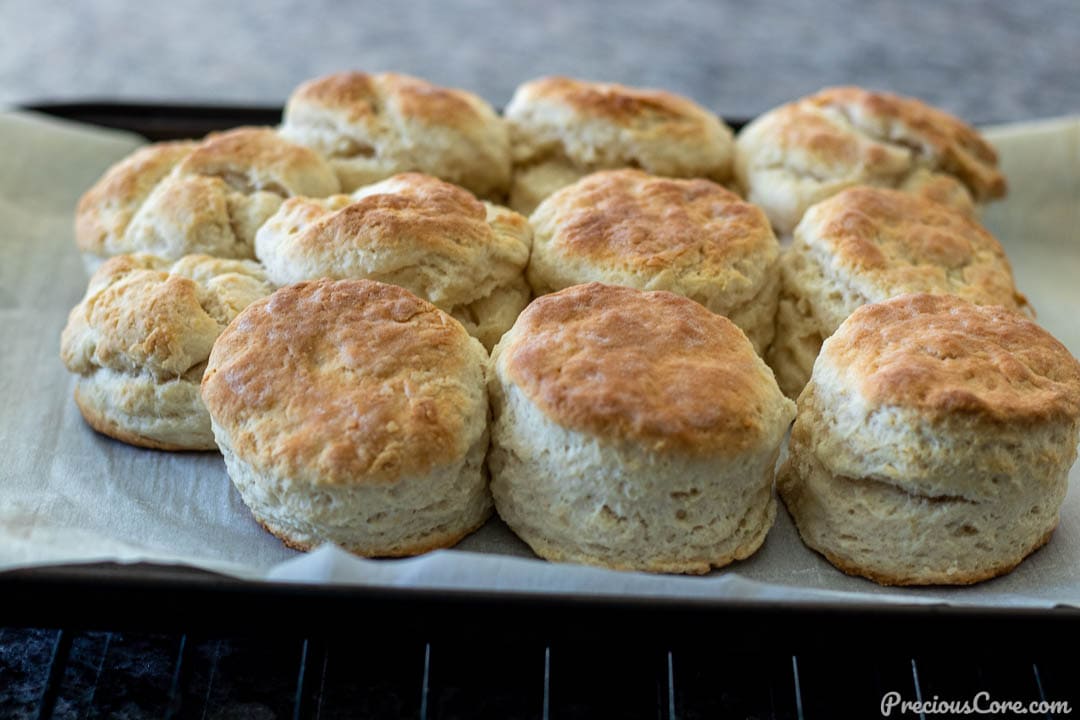How to Make the Best Buddha Bowl + 19 Easy Recipes
HurryTheFoodUp is reader-powered. If you click through using links on our site we may earn a small commission at no cost to you.
A buddha bowl filled with vibrant veggies and a delicious dressing is the ultimate plant-based meal. Here’s a simple guide to walk you through what it takes to make your very own buddha bowl! You’ll be a master in no time.
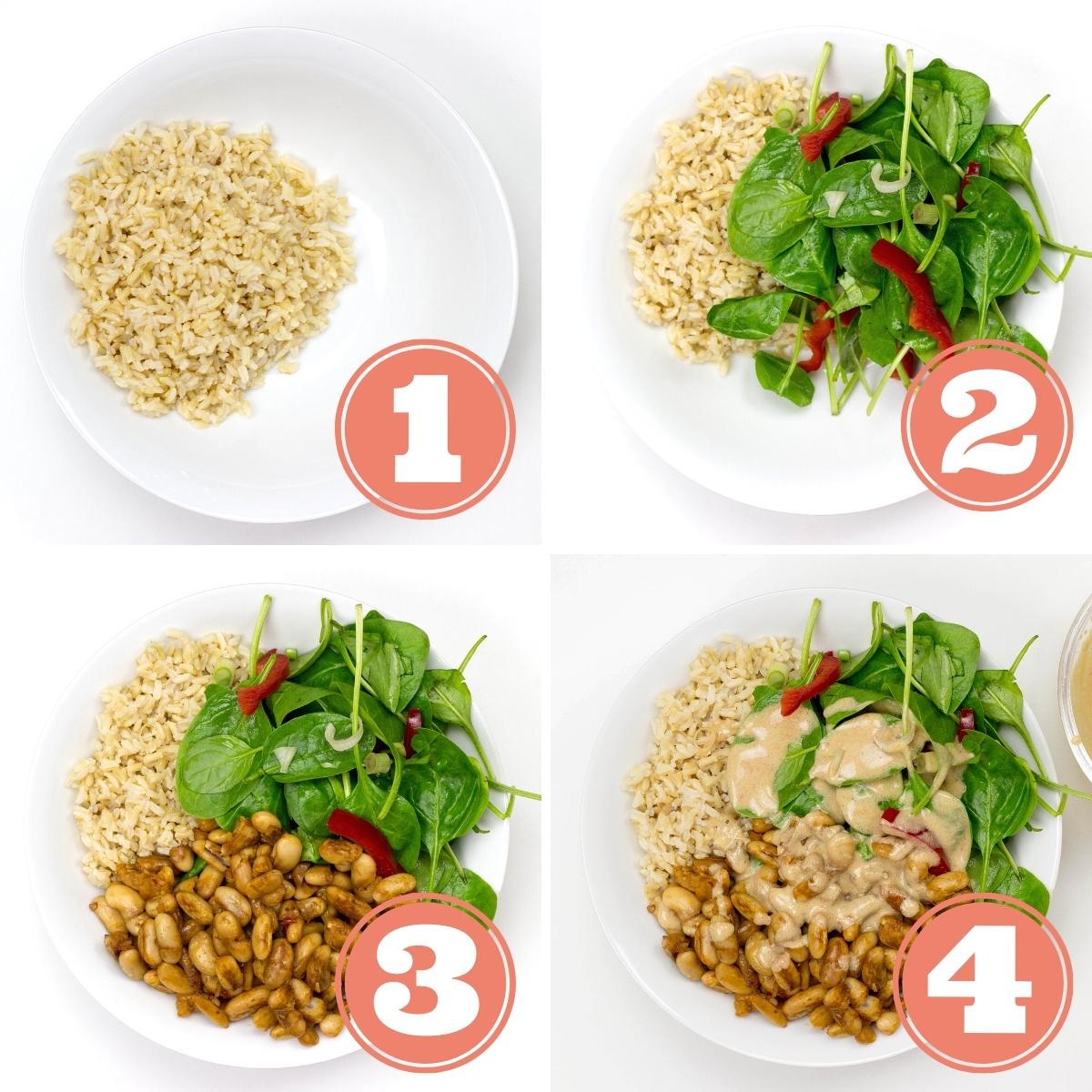
Before I go off on a tangent about how much I love this vegetarian meal, what really is a buddha bowl?
Well, a buddha bowl is essentially a one-bowl meal containing small portions of several types of plant-based ingredients that are usually served cold.
It is so-called as it is usually eaten from a bowl with a wide top – that signifies Buddha’s belly!
The basic buddha bowl usually consists of 5 key components. They are:
- A base – usually rice (like basmati or cauliflower rice) or a whole grain (quinoa)
- Plant-based protein source – tofu and tempeh provide a great deal of protein but so do the legumes here
- Fresh vegetables – corn, red onions, cauliflower, sweet potatoes and all sorts of other healthy veggies (that complement the other members of the dish!)
- Legumes – peas like snap peas, snow peas and chickpeas or some nuts as well as beans
- A nice dressing – peanut, hummus or tahini sauce as well as some sunflower seeds, herbs or avocadoes for the topping
Just writing this makes my mouth water as all these healthy ingredients are what make a buddha bowl the bright, colourful, nutritious and satisfying meal it is.
But, the real beauty of it is that you can make one pretty much however you want.
My journey to making bodacious buddha bowls and how you can begin yours
As a buddha bowl enthusiast, I’ve tried nearly any and every combo under the sun.
My very first bowl was a lip-smacking fusion of spicy roasted chickpeas, quinoa, kale, sautéed snap peas and butternut squash with a sweet and sour tahini sauce, garnished with some sesame seeds and watercress.
It was absolutely AMAZING and I’ve been cooking up more and more incredible buddha bowls ever since then.
Just by following a few teachings, you too can knock up a delicious and varied buddha bowl every time.
I’ve put together this guide with step-by-step instructions to make sure you always get your vegetarian buddha bowls right – easily and without fuss, just the way they should be. And so, without further ado:
Part 1: Grab a grain and prep it most deliciously.
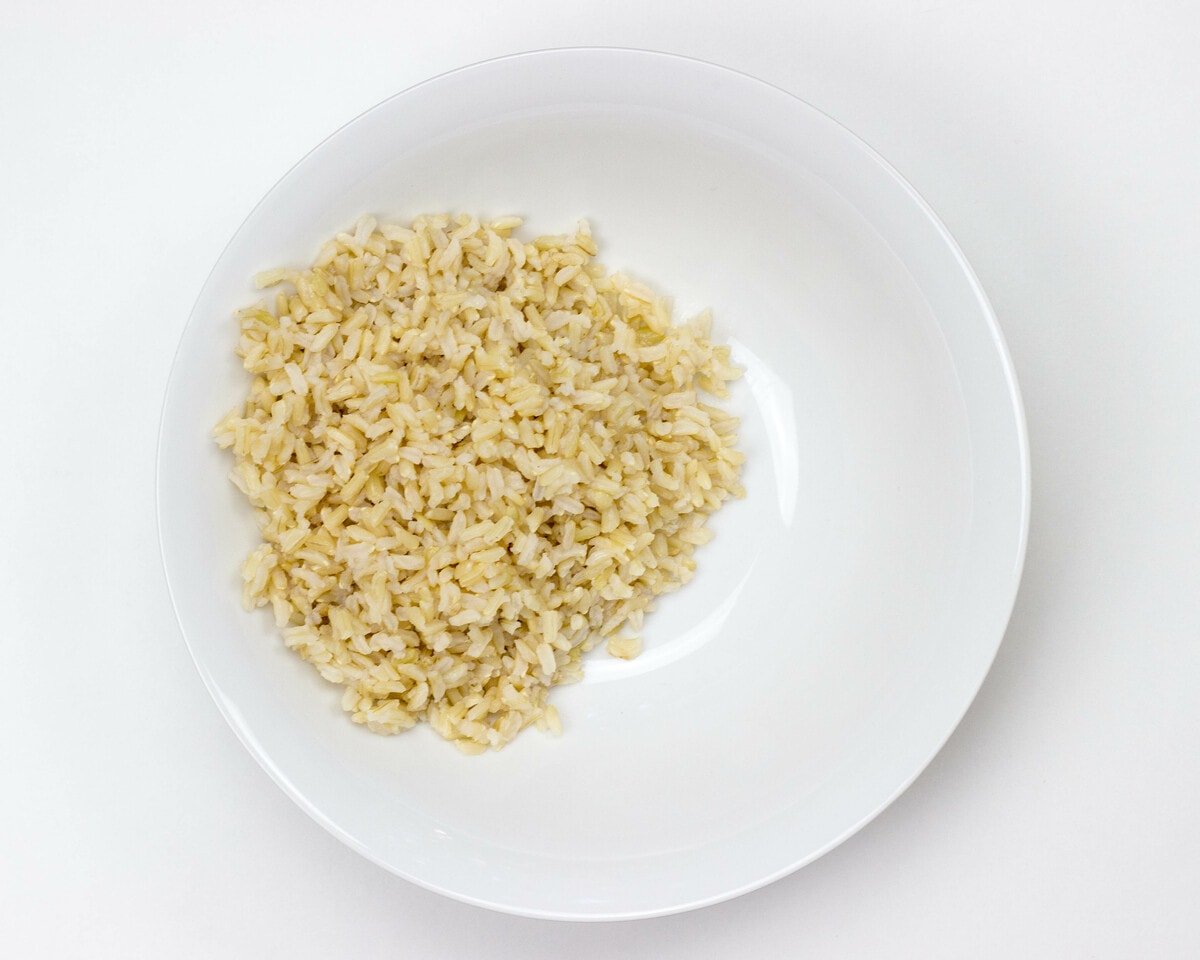
We’re going to focus on rice, to begin with here for simplicity’s sake – rice is a really easy way to start – and there are so many beautiful variations available.
There are many alternatives (and although not all of them are technically grains) you can also use quinoa, millet, freekeh, buckwheat, barley or couscous – whichever you like the most, suits your budget, or is the easiest for you to find at your local store.
To really enjoy your Buddha Bowl you need to learn how to make your grains taste awesome. If they are bland you won’t enjoy the dish.
Here are some examples of our favourite ways to cook delicious rice:
Basmati Rice – Three Ways
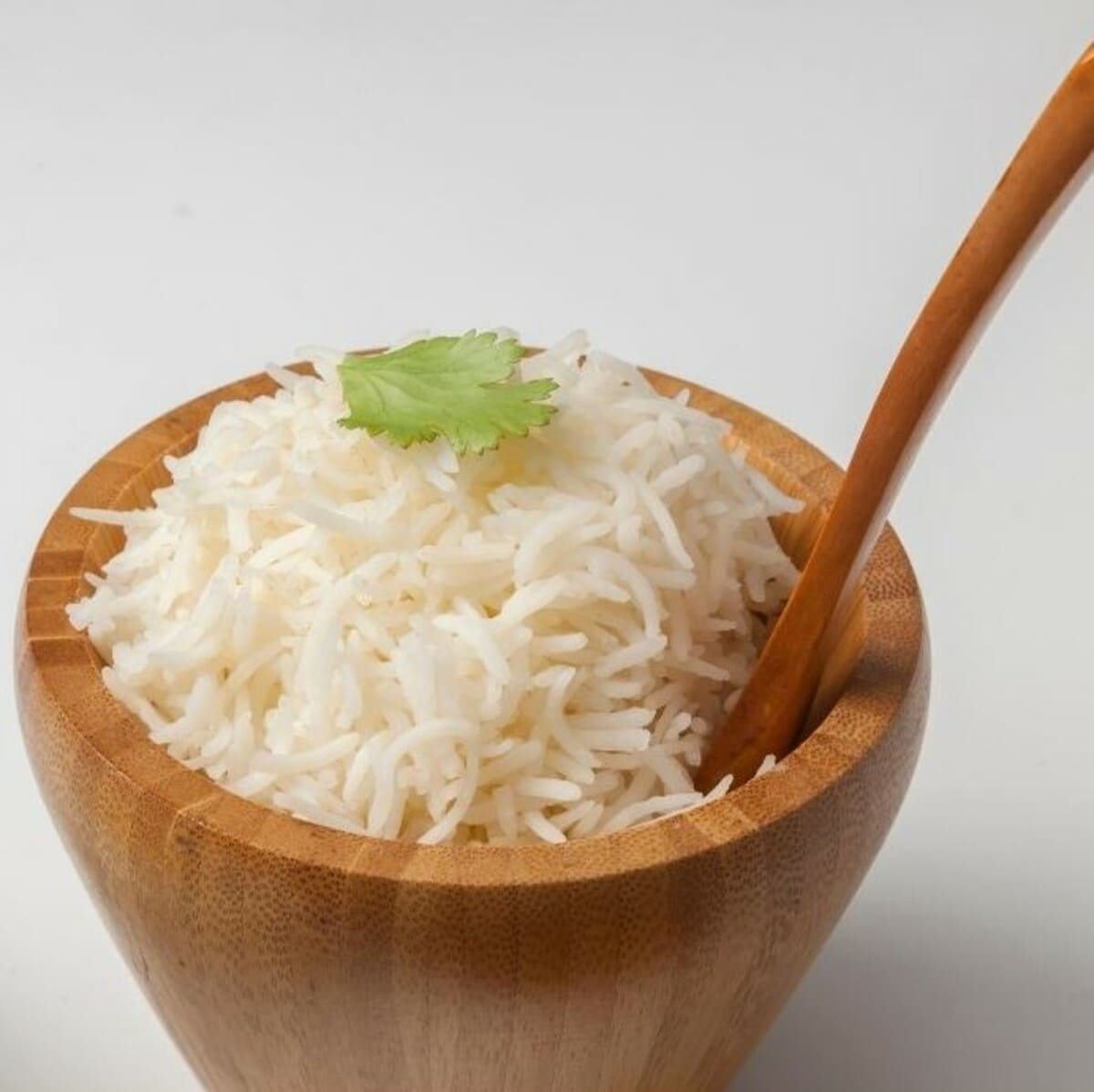
Ingredients for two:
- ½ cup basmati rice
- 1 cup cold water
- A pinch of salt
Directions:
Rinse the rice in a sieve (optional but great if you can!). Add the rice to a pot. Add water and salt, bring it to a boil. Pop the lid on top and put it on low heat for 8-10 minutes.
Check back when the time is up, fork through it to make it fluffy.
Optional but even more awesome: leave it for another 10 minutes to let excess moisture evaporate. Make sure to give the rice some extra flavour with spices and herbs!
Here are three combos you can add to the basic basmati rice recipe (serving 2):
Version 1: Indian Style – pick and choose from the spices below; experiment a little and see some exciting results! Add them to the rice as it’s cooking.
- 1 tsp of ground turmeric
- 1 tsp of cinnamon
- 1 tsp curry powder
- 3-4 cloves
- 2 pierced cardamom pods
Version 2: Cilantro Freshness – you can use any herbs you like but we love this version in particular.
Follow the basic recipe above but when the rice is cooked add a tbsp of olive oil, a few splashes of lime, and a handful of chopped cilantro/coriander. Season with more salt if needed. Citrusy fresh 🙂
Version 3: Sweet and Crunchy
When the basic rice is cooked stir in a handful of chopped walnuts, a handful of raisins or dried cranberries and a dash or two of balsamic vinegar.
Don’t worry if you don’t have all the ingredients to hand, throw in what you do have!
Check out Jamie Oliver’s video to see how easy cooking awesome rice really is. (But also a bit on the expensive side if you use as much safran as he does, ha!)
Mexican-Inspired Brown Rice
(you can use standard white rice as well, it cooks a little quicker too)
Ingredients for two:
- 1 tbsp of olive oil
- ½ cup of brown rice
- 1 cup of vegetable broth instead of water
- Half an onion
- Half a red bell pepper
- 1 tomato
- A pinch of salt
Directions:
Rinse the rice in a sieve (optional). Add the olive oil to a pot and put it on medium heat. Next, add the rice.
Let it fry for a 2-3 minutes while stirring every now and then (if making the Mexican version then add half an onion, half a bell pepper and the tomato). Add water (or broth) and salt, bring it to a boil.
Cover with a lid and put it on low heat for 20 – 25 minutes. Check back when the time is up, fork through it to make it fluffy.
Optional: leave it for another 10 minutes to let excess moisture evaporate.
Check out this post by The Kitchn for an even more detailed explanation on how to cook brown rice.
Jasmine Coconut Rice
Ingredients for two:
- 1/2 cup of coconut milk
- 1/2 cup water
- Teaspoon honey
- Pinch salt
- 1/2 cup uncooked jasmine rice
Directions:
In a saucepan, combine coconut milk, water, honey, and salt. Stir until sugar is dissolved. Stir in rice.
Bring to a boil over medium heat. Cover, reduce heat, and simmer for 18 to 20 minutes until rice is tender.
Other Flavours
Play around with the spices and liquids, add different herbs before serving, there is no right or wrong – that’s half the fun of a Buddha Bowl! Making good rice is a craft, and you’ll improve with every batch.
Other Grains
Remember we said you can use other healthy plant-based ingredients like couscous or quinoa? Well, we weren’t joking!
Trying subbing the rice for one of those – you can use the variations from above too.
Also if you’re in a rush then you can simply cook the grains in stock instead of water for an instant flavour hit – this is one of the very fastest ways to make a Buddha Bowl!
Part 2: Pick a veg and prep it the awesome way.

Now your rice or chosen grain is merrily cooking away, it’s time to get the ‘green’ ready. The green is going to be some delicious veggies and/or a leafy green that complements what you’ve made so far.
The key here is to create something tasty with a few simple ingredients.
Some evergreens are spinach, kale, cabbage, cauliflower, broccoli, asparagus, mushrooms, bell peppers, carrots, tomatoes, cucumbers, zucchini, onions, sprouts, avocado and spring onion.
But once again, there are no right and wrongs with this versatile and beautiful dish we call a Buddha Bowl.
Here are some tasty ways to get your greens and veg just right:
Sauteed Vegetables
Here we use bell peppers, but you can use whatever you’re in the mood for – or happen to have in the fridge, begging to be used up!
Ingredients for two:
- 2 bell peppers
- 1 tablespoon olive oil
- 1 onion
- Salt and pepper
- 1 tbsp of balsamic vinegar
Directions:
Cut the peppers in thin strips (“julienne”). Check out this video for some cool cutting-edge cutting tips. It’s funny too. After a few giggles heat the olive oil in a large nonstick pan over medium heat.
Add the bell peppers and onion; season with salt and pepper. If you have one, add a lid on top to keep in the steam. It’s not classic sauteing, but it helps to soften the veg more quickly.
Stir occasionally! When the bell peppers are soft (after about 10 minutes) add a splash of balsamic vinegar. Devine!
A Quick and Simple Salad
Here we use lettuce, carrot and rocket but you can use whichever raw veggies you like. There’s no cooking to be done here, just a bit of prepping.
To save even more time, you can use a bag of mixed salads.
Ingredients for two:
- 1/4 chopped lettuce (or similar)
- 1 grated carrot
- A handful of rocket
Directions:
Not much to say here – rinse the ingredients, peel and grate the carrot (unless it’s organic, then you can eat the skin), and chop the lettuce. Done.
Steamed Vegetables and Greens
One of the easiest and most nutritious ways to cook veg. Sounds exactly like it is. Once again, use your favourite veg, or simply what you have to spare.
Here I’m using a couple of different veg with different steaming times to give you an idea of how it goes.
Ingredients for two:
- 1.5 cups chopped broccoli
- 1.5 cups spinach leaves
Directions:
Bring about 3 cm of water to boil in a saucepan. Place the equally chopped broccoli in a steamer bowl (a metal sieve works fine too!) and place it on top of the boiling water. Cover with a lid.
Note – the veg should be above the water, not in it. After about three minutes add the spinach and let the steam finish its job.
Another three minutes should do it, and you’ll have some beautifully tender veg ready for your Buddha Bowl.
The above instructions are just an example – you can use whatever vegetables you want! Bear in mind that each veg takes a different length of time – you don’t want soggy greens!
This post has a great list of veg steaming times. To test a veg to see if it’s cooked, just poke it with a knife in the thickest area. If the knife slides in easily, it’s ready!
Part 3: Choose a legume and ‘av it the way you like.
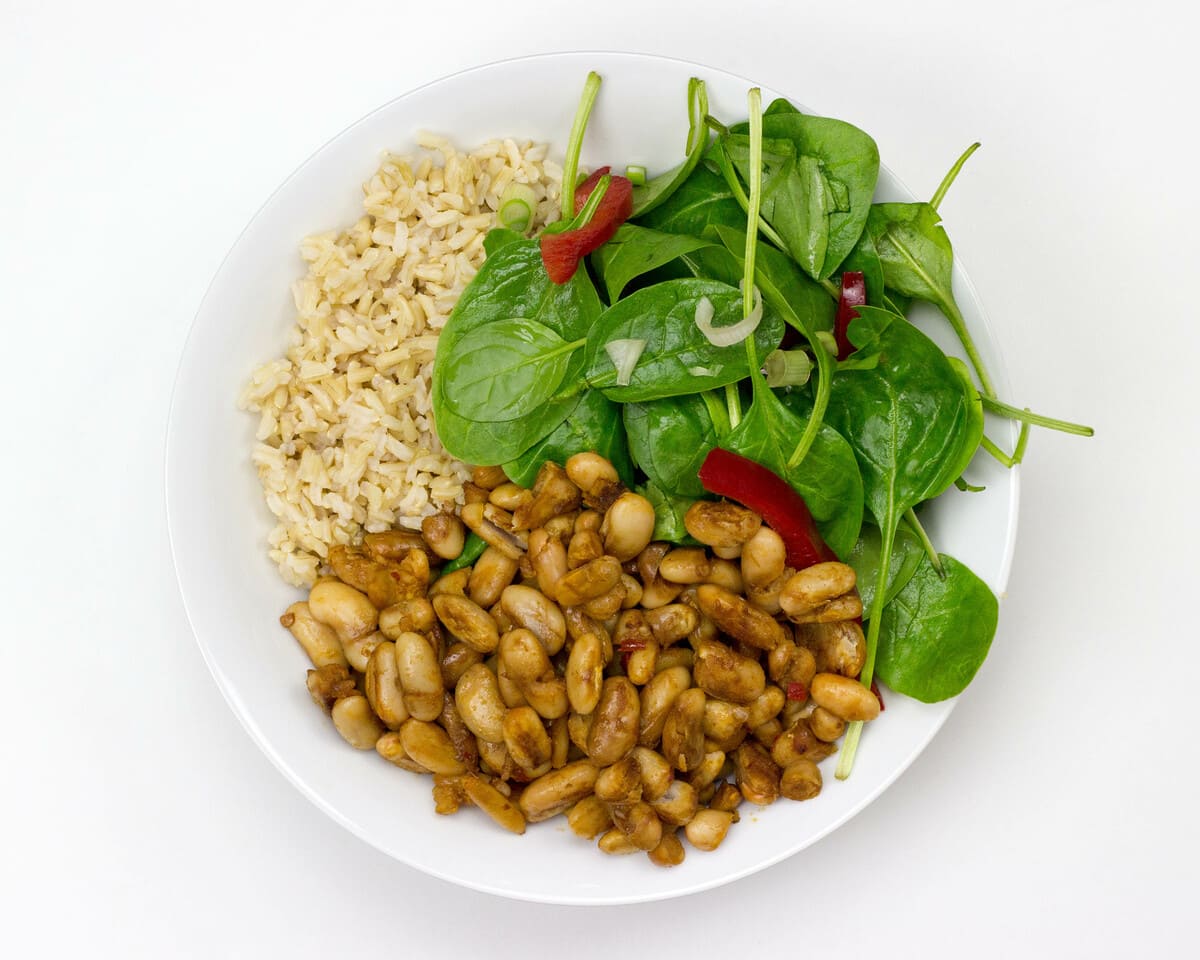
Legumes give our Buddha Bowl a big protein punch. Think black beans, kidney beans, white beans, black-eyed peas (not the band, obviously), chickpeas, red lentils, brown lentils, peas, edamame.
Also tofu, seitan or tempeh are great too!
It usually makes sense to just use canned ones for convenience but if you already have some cooked legumes in the fridge, that’s just fantastic!
Here’s how to make your legumes really tasty.
‘Raw’ or ‘sauteed’

Legumes usually taste awesome when just drained and rinsed out of the tin.
You can pimp them a little with lime, salt, pepper, some olive oil and/or herbs. Then just add them as they are to your Buddha Bowl. It’s the quickest and simplest way.
Alternatively: If you saute veggies then add some legumes in the last 2-3 minutes of sauteing. Done.
For a Buddha Bowl truly bursting in flavour here are some extra mouth-watering ideas.
Ginger Spiced Beans
Ingredients for two:
- 2 garlic cloves
- 2 cm fresh ginger
- 1 tin black/kidney beans (15.5 oz / 435g)
- 1 tbsp olive oil
- Juice of half a lime (maybe a little more)
Directions:
Grate or chop the garlic and ginger. Then fry both in oil on medium heat and in a large saucepan for a minute. Drain and rinse the beans, then add them to the pan.
Fry for a couple more minutes, adding a couple of tablespoons of water as you go. Finally, remove from the heat, add the salt, pepper and lime juice. You can mash the beans a little if you like.
Spicy Green Beans
Ingredients for two:
- 1 tsp olive oil
- 200g of green beans (a good handful), ends trimmed, chopped into bite-size pieces
- 2 cloves garlic, finely chopped
- 1 tsp soy sauce
- 1 tsp sambal oelek (or 2 tsp chili flakes)
Optional
- 1 tsp ginger, grated
- 1 tsp lemon juice
Directions:
Fry the garlic in oil on medium heat and in a large saucepan for a minute. Then add the green beans to the pan.
Fry for a couple more minutes, adding soy sauce and sambal oelek and optional ingredients as you go. Done.
Crispy Tofu Cubes
Ingredients for two:
- 1 pack of firm tofu (14oz, 400g)
- 4 tbsp of oil for frying, eg. peanut oil
- Some salt
Directions:
Slice the tofu into cubes, a little bigger than a regular die. Get a pan and fry the cubes in oil on a medium heat for about 15 minutes until golden brown.
Stir occasionally so they won’t stick to the pan. You might have to add a little oil every now and then. Make sure to season them with salt while they’re still sizzling!
Roasted Chickpeas
Ingredients for two:
- 1½ Cups/ 1 standard tin cooked chickpeas
- 1-2 tbsp olive oil
- ½ Tsp Salt
- ½ Tsp Paprika
- 1 Tsp Chili Powder
- ⅛ Tsp Turmeric
- ½ Tsp Oregano
Directions:
Place all the ingredients in one large bowl and mix until chickpeas are all coated. To get nice and crispy chickpeas, place the coated peas in a baking tray and put them in a preheated oven for about 15 minutes at 200°C/400°F.
Curried Chickpeas
Ingredients for two:
- 1 ½ cups/ 1 standard tin cooked chickpeas
- 2 tbsp curry paste – think red, green, yellow, tandoori, tikka – use your fave!
- 2 tbsp olive oil
- Salt and pepper to taste
Optional: A squeeze of lime if you have it.
Directions:
Much like above, mix all the ingredients together and coat the chickpeas evenly.
Either place them in a baking tray and roast in the oven as above, or fry in a pan on medium heat for about 8 mins for a slightly crispier option.
Part 4: Make an awesome dressing

A fancy dressing is not always necessary, especially if you’ve already pimped all the other ingredients.
If you want to keep it simple, just opt for some sambal oelek, sriracha, soy yoghurt or the good old combo of vinegar, olive oil, salt and pepper.
But at times, a dressing with an extra kick can do wonders. Here are four that definitely make any buddha bowl fun to eat. The ingredients are always enough for two servings:
Asian Style Peanut Butter Dressing
- 1 tbsp peanut butter
- 1 tbsp soy sauce
- 1 tbsp honey or maple syrup to make it vegan
- 1 tbsp vinegar or lemon
- 2-3 tbsp water
- A pinch or two of chopped or grated ginger (dried is fine)
Spicy-Orange Vinaigrette
- a good orange squeeze (about 2 tbsp)
- 1 tsp soy sauce
- 1 tsp sesame oil
- 1 tsp sambal oelek or sriracha
- 1 tsp rice vinegar
Vegan Caesar Dressing (Howie’s Favourite!)
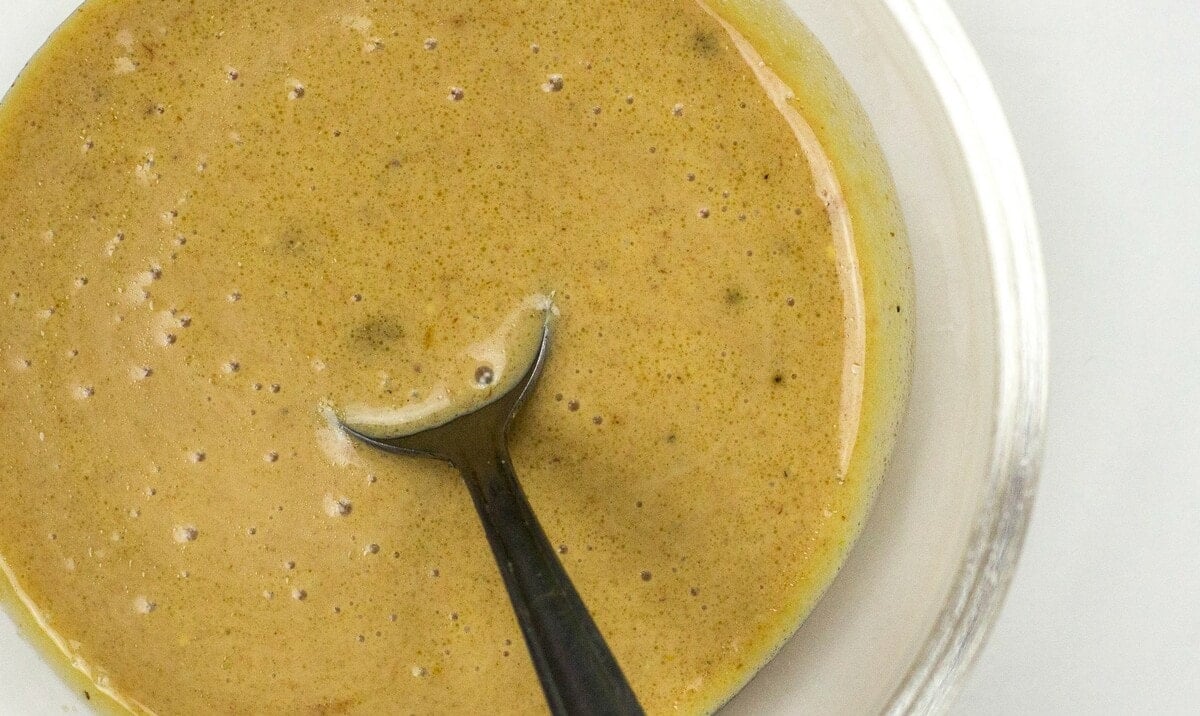
- 50ml Soy milk
- 2 tbsp Olive Oil
- ½ tsp garlic powder
- 1 tsp mustard
- 1 tsp tomato paste
- 2 tsp vinegar
- Salt & Pepper
Optional: drop of maple syrup
Red Pepper Sauce
- 1 red bell pepper
- 2 tbsp olive oil
- Juice of half a lemon
- ½ tsp salt
- ½ tsp pepper
- ½ tsp cayenne pepper
- ¼ cup cilantro or parsley (you can use dried or frozen too of course)
Optional: A couple of chilies if you want it spicy!
Roughly chop the bell pepper (minus the core and seeds), and add it with the rest of ingredients to a blender or large bowl and blend!
A hand blender works really well for this. That’s it, sauce ready!
How to Make the Best Buddha Bowl + 19 Easy Recipes
Here’s an easy guide to making the most colourful buddha bowls, packed with all sorts of plant-based goodness and garnished with a tasty sauce.
- ½ cup uncooked grains (rice, quinoa, millet, freekeh, buckwheat, barley or couscous)
- 3 cups leafy greens (some favourites are spinach, kale, cabbage, cauliflower, broccoli, asparagus, mushrooms, bell peppers, carrots, tomatoes, cucumbers, zucchini, onions, sprouts, avocado and spring onion)
- 1 cup cooked legumes (1 cup = 1 can / 15.5 oz / 435g; black beans, kidney beans, white beans, black eyed peas, chickpeas, red lentils, brown lentils, peas, edamame. Also tofu, seitan or tempeh works.)
- Step 1: Cook the grain
½ cup uncooked grains
- Step 2: Prep the greens
3 cups leafy greens
- Step 3: Prep the legumes
1 cup cooked legumes
- Step 4: Whip up a nice dressing
- Add everything together in one bowl.
- Enjoy while doing the downward dog 😉
For the dressing try sriracha, soy yogurt or a combo of vinegar, olive oil, salt and pepper.
Nutrition Facts
How to Make the Best Buddha Bowl + 19 Easy Recipes
Amount per Serving
% Daily Value*
* Percent Daily Values are based on a 2000 calorie diet.
Our Favourite Buddha Bowl Combos
As we mentioned (once or twice), part of the joy of a Buddha Bowl is doing it your own way. Experiment, have fun and try out different harmonious flavour unions.
If you’re really struggling, then here are a few of our favourites to help you on your way. And one or two not to try 😉
Indulge with this smoky and savory Buddha Bowl. The combination of smoked tofu, hummus, and turmeric rice makes for a perfect vegan lunch (or dinner!)
Four easy steps to a delicious and nutritious crispy, crunchy potato lunch. Make your colleagues jealous!
This easy (and animal-friendly) lunch and dinner bowl hits all the right spots – grains, greens and a legume! What’s not to like?
Buddha Bowl FAQ
I’ve pretty much given you all the know-how to make the best buddha bowls on the planet but if there’s something you still have your doubts about, leave it in the comments below.
Are buddha bowls healthy?
A buddha bowl is a prime example of a well-balanced and healthy meal with each component providing a range of health benefits.
Besides the high levels of plant proteins, vitamins and other essential nutrients in whole grains and vegetables, there are many health benefits of consuming whole grains and there’s a wide range of medical advantages associated with vegetables.
And, the best part is, you’ll be getting the bulk of all those regardless of which grain you use for the base or vegetables you choose to include in these colourful bowls!
How long do certain ingredients keep fresh in the fridge?
- Cooked quinoa lasts for 6 days
- Cooked rice lasts for 5 days
- Cooked beans last for 5 days
- Cooked lentils last for 5 days
So, cooking up multiple servings of grains or having a half-emptied can of beans is not a problem at all.
Just refrigerate them and make another Buddha Bowl within the next couple of days. Easy.
Right then, you now know the basic tips and tricks of building a proper Buddha Bowl.
After all, it really comes down to your creativity. Just follow the basic construction ideas and you’ll be making feast after feast.
More Buddha Bowl Recipe Ideas
- Mexican style couscous, 1 yellow bell pepper and 2 spring onions (chopped, raw), raw kidney beans and a splash of sweet and sour sauce.
- Indian style rice, steamed spinach and curried chickpeas.
- Sweet and crunchy couscous with fresh salad and a dash of your favoured sauce.
- Mexican-style quinoa, sauteed bell peppers and red pepper sauce eaten cold.
- Mexican style brown rice, spinach and julienned bell peppers, “sauteed” spicy white beans
I’ve only found one combination that truly didn’t work so far: coconut rice with caesar dressing. Amazing separately but they’ll be stabbing backs before we know it 😉

More Buddha Bowl Recipes
And finally – If you’re still thirsty… or even hungry for more inspiration, check out these 16 plant-based Buddha Bowl recipes.
Not all of them follow the “rules” of this guide, and some of them take longer than the usual 30 minutes you’re used to on our blog, but they’re all awesome…and vegan too!
Nourish Buddha Bowl – The classic buddha bowl
Sweet Spicy Asian Brown Rice and Pineapple Bowl – An exciting vegan buddha bowl recipe
Simple Vegan Burrito Bowl – Satisfying and Mexican!
Roasted Veggie Buddha Bowl – Includes a tasty pesto sauce
Veggie Rice Buddha Bowl – With a lemon herb sauce, cool!
Peanut Tofu Buddha Bowl – Dat peanut sauce!! 😀
Chili Orange Veggie Bowl – Steam your veg!
Rice Bowl with Sorrel, Kale, Lemon and Radishes!
Fall Buddha Bowl with Quinoa – Comforting and healthy!
Rice, Black Bean and Avocado Bowl – With a Sweet Chili Mustard Sauce!
Tropical Buddha Bowl – This is filling and refreshing at the same time
Sesame Garlic Buddha Bowl – Love the flavours of this delicious recipe!!
15 Minute Buddha Bowl – This one is fun to eat!
Winter Buddha Bowl – Lentils, sweet potato and a lovely vinaigrette
Spring Buddha Bowl – With asparagus and other amazing fresh veggies 🙂
Buddha Bowl with Red Pepper Sauce and Roasted Chickpeas – Wow!
Did I leave anything blurry? (Ah Blurry, there’s a great song I haven’t heard for ages!) Just pop any questions in the comments and I’ll help however we can!
I’m always eager to hear any food-related story – have you made a Buddha Bowl before? What “grain, green, bean combo” did you go for?
A delicious and colourful buddha bowl is an incredibly healthy plant-based meal that’s fun and super easy to do too. If you made any of these recipes, be sure to leave some feedback telling me how it went!


